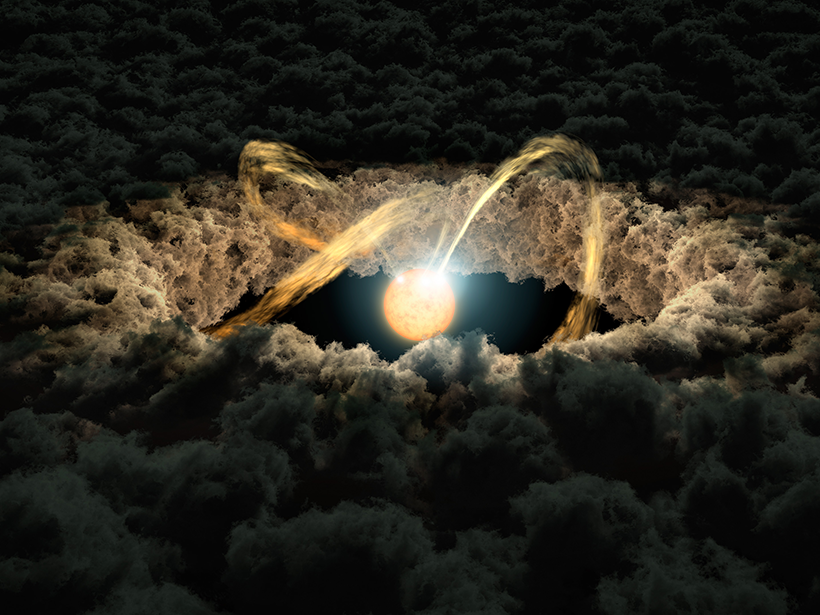A protoplanetary disk in a rare configuration is providing insights into how passing objects may influence the way planets form.
“If the collision occurs during planet formation, the orbits of [the young] planets are scattered drastically. Some of them could be pushed out from the planetary system and exist as free-floating planets.”
Surrounding the star SU Aurigae, the protoplanetary disk features an extended tail of gas and dust. New research suggests that the tail most likely formed as a result of a flyby from a substellar object, which dragged out some of the gas and dust from the disk. Interactions between disks and passing objects may help to explain the wide variety of planetary systems spotted around other stars, according to research published in the Astronomical Journal.
Stars form when a cloud of gas and dust collapses in on itself. After a star is born, leftover material can spin into a disk that can go on to build planets. Passing stars, clouds of gas, and even giant planets can gravitationally collide with the young disk, shaking up how young planets evolve.
“If the collision occurs during planet formation, the orbits of [the young] planets are scattered drastically,” says Eiji Akiyama, an astronomer at Japan’s Hokkaido University and the lead author of the new research. “Some of them could be pushed out from the planetary system and exist as free-floating planets.”
Tracking Down the Tail
Akiyama and his colleagues had previously studied SU Aurigae with the Subaru Telescope on top of Hawaii’s Mauna Kea. They found the young disk had a small tail of dust that extends approximately 350 astronomical units (AU), where 1 AU is the distance between Earth and the Sun. The discovery piqued their interest, and they decided to probe the disk again with the Atacama Large Millimeter/submillimeter Array (ALMA) in Chile to better understand the unusual feature. ALMA revealed an even longer, gas-filled tail that stretched more than 1,000 AU.
The most likely candidate for creating the tail is a passing substellar object, according to the authors. As a brown dwarf or giant planet zipped by the newborn star, material in the outskirts of the disk would have felt a stronger gravitational pull from the interloper than from its sun. According to Akiyama, the substellar object would have made its pass only a few hundred years ago, an eyeblink in astronomical timescales.
Although it’s possible that the tail could have been formed by a planet ejected from the disk itself, the authors think that scenario is unlikely because the motion of the tail appears to argue against it. Objects from inside the disk would continue to rotate around the star, creating a curved tail that would wrap around it. Instead, the tail stretches away from the star.
“I think it’s quite exciting to see this kind of data.”
The tail is “almost running away from [the star],” says Joseph Rodriguez, an astronomer at the Harvard-Smithsonian Center for Astrophysics not involved in the research. Like breadcrumbs, the escaping tail could indicate the direction the intruder traveled.
Rodriguez studied RW Aurigae, whose tail was most likely created by a companion star. So far, SU Aurigae and RW Aurigae are the only protoplanetary disks known to have an extended stream of material. The question Rodriguez and his colleagues are pondering is whether that’s because such interactions are rare or because they just haven’t been spotted yet.
Anna Miotello, a postdoctoral fellow at the European Southern Observatory in Germany who was not part of the research, suspects that the limits of technology play a significant role in the lack of evidence of such disks. Although protoplanetary disks have been observed for decades, ALMA has provided more detailed observations of only a handful of objects.
“I think it’s quite exciting to see this kind of data,” Miotello says.
Both Rodriguez and Miotello agree that more such disks need to be observed to better understand how they affect the way planets form. In the meantime, Akiyama and his team are turning their eyes back toward SU Aurigae to take a more in-depth look at the tail with ALMA.
“We will try to find the origin of the tail-like structure,” Akiyama says. “It will tell us how such a structure impacts planetary formation.”
—Nola Taylor Redd ([email protected]), Science Journalist
Citation:
Redd, N. T. (2019), Passing object may have kicked up dust from a planetary disk, Eos, 100, https://doi.org/10.1029/2019EO123787. Published on 16 May 2019.
Text © 2019. The authors. CC BY-NC-ND 3.0
Except where otherwise noted, images are subject to copyright. Any reuse without express permission from the copyright owner is prohibited.

